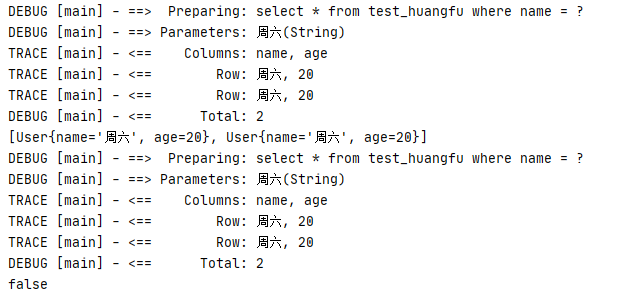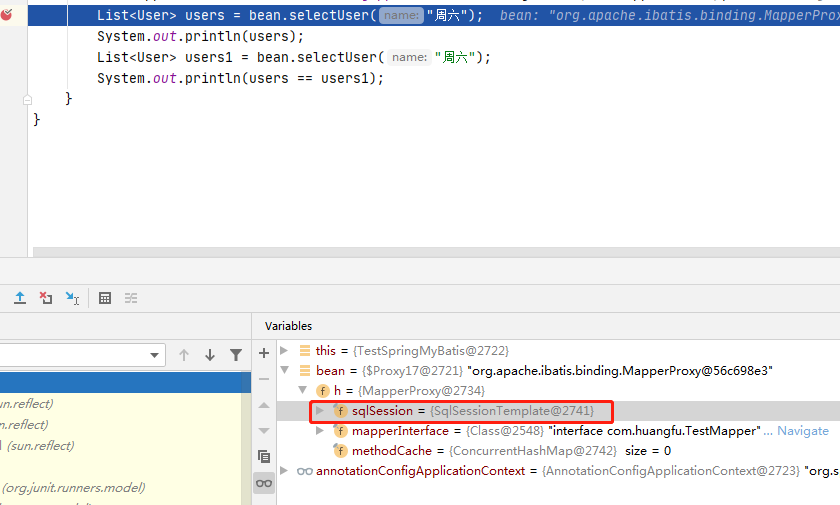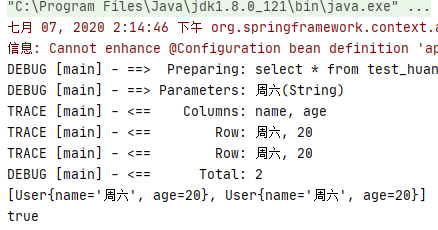你凭什么说Spring会导致MyBatis的一级缓存失效!
一、概述
最近老是听说Spring和MyBtis集成后,一级缓存就不可用了!
我就纳闷了,为什么一级缓存不可用呢?这难道是Spring的BUG?这引起了我极大的兴趣,因为Spring作为一个极其优秀的项目管理框架,它居然也有BUG,我要一探究竟,满足我的好奇心!
二、真的没走缓存
为了帮助我查看源码,我把MyBatis和Spring集成后写了如下代码:
AnnotationConfigApplicationContext annotationConfigApplicationContext;
@Before
public void init(){
annotationConfigApplicationContext = new AnnotationConfigApplicationContext(AppConfig.class);
}
@Test
public void selectTest(){
TestMapper bean = annotationConfigApplicationContext.getBean(TestMapper.class);
List<User> users = bean.selectUser("周六");
System.out.println(users);
List<User> users1 = bean.selectUser("周六");
System.out.println(users == users1);
}
复制代码
讲道理,以上代码在常规的环境下,是一定会走一级缓存的,因为他满足一级缓存命中的条件,即同一个 SqlSession
、 StatementId
相同, 参数
相同、 分页条件
相同、 查询语句
相同、 环境名称
相同 六大命中规则,所以理论上,一级缓存是一定会命中的!但是事实上日志如下:

他居然没有走缓存,而是去查询了两遍数据库,一级缓存华丽丽的的失效了,可是这道理是为什么呢?
三、失效的原因
Spring作为一个顶级项目管理框架,对于如此明显的BUG,他不可能发现不了,及时真的发现不了,那么github上使用者也不可能不提BUG,于是,我打断点调试调试,看下源码就是是如何来操作的!
从哪里下手呢?刚刚我们说过一级缓存的命中规则,2,3,4,5,6条规则一定是一样的,因为我只是单纯的复制了两遍查询,代码上没有变动,所以他的查询语句、参数之类的条件一定是相同的,那么最可能出现的条件就是第一条: 同一个SqlSession
,难道说Spring集成MyBatis后,每一次查询都是用了不同的SqlSession? 以前看过我文章的都应该知道,我之前分析过一篇关于MyBatis设计模式的文章,关于门面模式中说到过: 每一个SqlSession都会有一个唯一的执行器(Executor)与之对应
,所以说如果想验证是不是同一个SqlSession,只需要验证两次使用的执行器是不是一个就OK了,说做就做,我在 BaseExecutor#query
方法上断点,结果如下:

果然不出我所料,两次查询走的根本不是一个执行器,那么也就一定不是一个SqlSession,这下只掉原因了,但是为什么呢?
四、罪魁祸首

通过上图的断点我们可以看出来,正常情况下,我们的Mapper代理里面所包含的应该是 DefaultSqlSession
对象,但是通过整合Spring后我们发现,我们的SqlSession对象被偷梁换柱了,换成了 SqlSessionTemplate
类,我们进入到这个类中:
public class SqlSessionTemplate implements SqlSession, DisposableBean {...}
复制代码
发现这个类也继承了 SqlSession
接口,那就好办了,那么查询的方法一定是经过Select方法来实现的,我们进入到他的 selectList
方法,看下他的实现逻辑:
@Override
public <E> List<E> selectList(String statement, Object parameter) {
return this.sqlSessionProxy.selectList(statement, parameter);
}
复制代码我们发现,这个方法内部内部的查询似乎又交给了一层代理,由这一层代理去真正执行的查询操作,我们似乎快找到原因了:
public SqlSessionTemplate(SqlSessionFactory sqlSessionFactory, ExecutorType executorType,
PersistenceExceptionTranslator exceptionTranslator) {
... 忽略不必要的代码...
this.sqlSessionProxy = (SqlSession) newProxyInstance(SqlSessionFactory.class.getClassLoader(),
new Class[] { SqlSession.class }, new SqlSessionInterceptor());
}
复制代码
果不其然,这个对象在初始化的时候,将这个代理对象也连带着初始化了,这个正是使用的JDK的动态代理来实现的,熟悉动态代理的同学可能会知道,JDK动态代理的精髓也就是 InvocationHandler
的子类,也就是 SqlSessionInterceptor
,我们进入到里面看一下他的实现:
private class SqlSessionInterceptor implements InvocationHandler {
@Override
public Object invoke(Object proxy, Method method, Object[] args) throws Throwable {
//获取SqlSession
SqlSession sqlSession = getSqlSession(SqlSessionTemplate.this.sqlSessionFactory,
SqlSessionTemplate.this.executorType, SqlSessionTemplate.this.exceptionTranslator);
try {
//反射调用真正的处理方法
Object result = method.invoke(sqlSession, args);
if (!isSqlSessionTransactional(sqlSession, SqlSessionTemplate.this.sqlSessionFactory)) {
//提交数据
sqlSession.commit(true);
}
//返回查询的数据
return result;
} catch (Throwable t) {
//。。。。忽略不必要代码
} finally {
if (sqlSession != null) {
//关闭SqlSession的连接
closeSqlSession(sqlSession, SqlSessionTemplate.this.sqlSessionFactory);
}
}
}
}
复制代码
既然SqlSession不一致,那么肯定是在获取SqlSession的时候,里面实现了一些逻辑,从而造成了 SqlSession的不一致,我们进入到 getSqlSession
方法中:
public static SqlSession getSqlSession(SqlSessionFactory sessionFactory, ExecutorType executorType,
PersistenceExceptionTranslator exceptionTranslator) {
//...忽略不必要代码....
//从ThreadLocal变量里面获取当前的SqlSession的处理器
SqlSessionHolder holder =
(SqlSessionHolder)TransactionSynchronizationManager.getResource(sessionFactory);
//如果事务同步管理器处于活动状态则从SqlSessionHolder获取Session
SqlSession session = sessionHolder(executorType, holder);
if (session != null) {
return session;
}
//如果SqlSessionHolder中获取的SqlSession为空,则新建一个SqlSession
session = sessionFactory.openSession(executorType);
//若事务同步管理器处于活动状态则将SqlSession设置到SqlSessionHolder中保存起来,以便下次使用
registerSessionHolder(sessionFactory, executorType, exceptionTranslator, session);
return session;
}
复制代码
原来如此,原来并不是说Spring使MyBatis的一级缓存失效了,而是因为Spring只有在开启了事务之后,在同一个事务里的SqlSession会被缓存起来,同一个事务中,多次查询是可以命中缓存的!我们回到 SqlSessionInterceptor#invoke
方法里面,他在关闭的SqlSession的时候同样对 是否开启事务做了处理,我们看 closeSqlSession
方法的源码:
public static void closeSqlSession(SqlSession session, SqlSessionFactory sessionFactory) {
//........忽略不必要的代码
SqlSessionHolder holder =
(SqlSessionHolder) TransactionSynchronizationManager.getResource(sessionFactory);
//查看事务同步管理器是否存在 session
if ((holder != null) && (holder.getSqlSession() == session)) {
holder.released();
} else {
//如果不存在就将该Session关闭掉
session.close();
}
}
复制代码那么,既然导致一级缓存失效的罪魁祸首我们找到了,如何解决呢?
五、解决方案
为什么一级缓存失效,因为两次查询没有使用同一个事物,那么我们加上同一个事物,看看情况如何:
@Test
public void selectTest(){
TestMapper bean = annotationConfigApplicationContext.getBean(TestMapper.class);
//添加事务
DataSourceTransactionManager dataSourceTransactionManager =
annotationConfigApplicationContext.getBean(DataSourceTransactionManager.class);
TransactionStatus transaction =
dataSourceTransactionManager.getTransaction(new DefaultTransactionDefinition());
List<User> users = bean.selectUser("周六");
System.out.println(users);
List<User> users1 = bean.selectUser("周六");
System.out.println(users == users1);
}
复制代码我们这个时候来看一下结果:

果然不出我所料,一级缓存又被成功的使用上了。
古人云:耳听为虚,眼见为实!只有真正的经历过,才知道哪些是真,哪些是假!这一次调试源码,不光让我对Spring整合MyBatis有了一个整体的认知,更是让我对动态代理有了一个更加深入的了解,后续我会整理一下,分享出来!
才疏学浅,如果文章中理解有误,欢迎大佬们私聊指正!欢迎关注作者的公众号,一起进步,一起学习!

本文使用 mdnice 排版
- END -
- 本文标签: NSA Select dataSource bean bug 数据库 IDE HTML 同步 Action id https 数据 App final 处理器 IO git 调试 CTO spring集成 Persistence 一级缓存 缓存 UI 设计模式 参数 文章 executor Proxy 源码 map 代码 分页 项目管理 sqlsession newProxyInstance ssl GitHub mybatis http mapper Statement spring sql 管理 list src SqlSessionFactory session 云 cat
- 版权声明: 本文为互联网转载文章,出处已在文章中说明(部分除外)。如果侵权,请联系本站长删除,谢谢。
- 本文海报: 生成海报一 生成海报二











![[HBLOG]公众号](https://www.liuhaihua.cn/img/qrcode_gzh.jpg)

